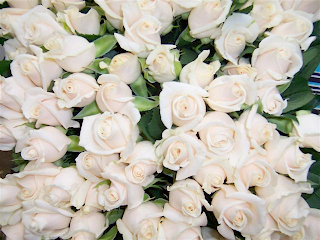 | |
| Plant, around 1980, red, black crystal glass, blown, pinched thread of aquamarine glass.(*) |
I would like to have a room, an empty room.
In a sunny day of winter, I would lift my pots from the terrace and store them in the room, lining up unknown species of cactus on a table by the window.
Cacti, plants and other flowers in glass were part of the exhibit “The Flowers of Murano. Works in Glass from the Bersellini Collection 1920-2010,” held at the Bagatti-Valsecchi Museum in Milan from May to July 2012. Floral themes inspired these beautiful and elegant objects created by famous Venetian glass masters, heirs of a tradition developed in Venice during the 17th century. They used different styles and tecniques for contemporary objects that returned the natural world from realistic flowers to monstruous fantastic shapes. Cacti were among the favourite plants. Reading the interesting introduction in the catalogue, I discovered that this choice was not accidental. Around 1930, "real succulents along with reproductions in painted wood, ceramic and especially Murano glass."(1) were highly fashionable plants for home furnishing.
And, for a couple of months, beautiful flowers and plants in glass decorated the refined rooms of the Bagatti-Valsecchi Museum, an apartment at the first floor of an old palace in the heart of Milan where the rich collection of artworks and furnishings collected by two noble brothers, Fausto and Giuseppe Bagatti Valsecchi, at the end of the XIX century is on display.
I would wait for the snow, with my precious cacti safe inside my room.
 | ||
| Cactus, around 1980, black glass, crystal, blown, red and aquamarine vitreous threads worked with pincers.(*) |
 |
| Various Plants and Plants with Flower, around 1980.(*) |
(*) Pauly & C. - Compagnia di Venezia e Murano. Replica of models by Ercole Barovier presented at the XVI Venice Biennale in 1928.
Note:
(1) Pg. 28, I Fiori di Murano, Catalogue.
Photos:
TravelinaGarden, Milan, May 2012.
Further reading:
I fiori di Murano. Opere in vetro dalla collezione Bersellini 1920-2010.
The Flowers of Murano. Works in Glass from the Bersellini Collection, 1920-2010. Curated by Rosa Barovier Mentasti, Sandro Pezzoli, Cristina Tonini, Marsilio, Venezia 2012.
Links:
Bagatti Valsecchi Museum, Via Gesù 5, Milano.
http://museobagattivalsecchi.org/en/evento/11/i_fiori_di_murano.html













